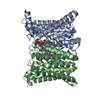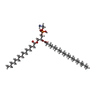[English] 日本語
 Yorodumi
Yorodumi- PDB-8ght: Cryo-electron microscopy structure of the zinc transporter from B... -
+ Open data
Open data
- Basic information
Basic information
| Entry | Database: PDB / ID: 8ght | ||||||
|---|---|---|---|---|---|---|---|
| Title | Cryo-electron microscopy structure of the zinc transporter from Bordetella bronchiseptica | ||||||
 Components Components | Putative membrane protein | ||||||
 Keywords Keywords | TRANSPORT PROTEIN / zinc transporter / dimer / complex / metal binding / inward-open inhibited conformation | ||||||
| Function / homology | Zinc/iron permease / ZIP Zinc transporter / zinc ion transmembrane transporter activity / plasma membrane / : / PHOSPHATIDYLETHANOLAMINE / Zinc transporter ZIPB Function and homology information Function and homology information | ||||||
| Biological species |  Bordetella bronchiseptica (bacteria) Bordetella bronchiseptica (bacteria) | ||||||
| Method | ELECTRON MICROSCOPY / single particle reconstruction / cryo EM / Resolution: 3.05 Å | ||||||
 Authors Authors | Liu, Q. / Chai, J. / Pang, C.X. / Shanklin, J. | ||||||
| Funding support |  United States, 1items United States, 1items
| ||||||
 Citation Citation |  Journal: Nat Commun / Year: 2023 Journal: Nat Commun / Year: 2023Title: Structural mechanism of intracellular autoregulation of zinc uptake in ZIP transporters. Authors: Changxu Pang / Jin Chai / Ping Zhu / John Shanklin / Qun Liu /  Abstract: Zinc is an essential micronutrient that supports all living organisms through regulating numerous biological processes. However, the mechanism of uptake regulation by intracellular Zn status remains ...Zinc is an essential micronutrient that supports all living organisms through regulating numerous biological processes. However, the mechanism of uptake regulation by intracellular Zn status remains unclear. Here we report a cryo-electron microscopy structure of a ZIP-family transporter from Bordetella bronchiseptica at 3.05 Å resolution in an inward-facing, inhibited conformation. The transporter forms a homodimer, each protomer containing nine transmembrane helices and three metal ions. Two metal ions form a binuclear pore structure, and the third ion is located at an egress site facing the cytoplasm. The egress site is covered by a loop, and two histidine residues on the loop interact with the egress-site ion and regulate its release. Cell-based Zn uptake and cell growth viability assays reveal a negative regulation of Zn uptake through sensing intracellular Zn status using a built-in sensor. These structural and biochemical analyses provide mechanistic insight into the autoregulation of zinc uptake across membranes. | ||||||
| History |
|
- Structure visualization
Structure visualization
| Structure viewer | Molecule:  Molmil Molmil Jmol/JSmol Jmol/JSmol |
|---|
- Downloads & links
Downloads & links
- Download
Download
| PDBx/mmCIF format |  8ght.cif.gz 8ght.cif.gz | 126.5 KB | Display |  PDBx/mmCIF format PDBx/mmCIF format |
|---|---|---|---|---|
| PDB format |  pdb8ght.ent.gz pdb8ght.ent.gz | 81.9 KB | Display |  PDB format PDB format |
| PDBx/mmJSON format |  8ght.json.gz 8ght.json.gz | Tree view |  PDBx/mmJSON format PDBx/mmJSON format | |
| Others |  Other downloads Other downloads |
-Validation report
| Summary document |  8ght_validation.pdf.gz 8ght_validation.pdf.gz | 1.1 MB | Display |  wwPDB validaton report wwPDB validaton report |
|---|---|---|---|---|
| Full document |  8ght_full_validation.pdf.gz 8ght_full_validation.pdf.gz | 1.1 MB | Display | |
| Data in XML |  8ght_validation.xml.gz 8ght_validation.xml.gz | 28.5 KB | Display | |
| Data in CIF |  8ght_validation.cif.gz 8ght_validation.cif.gz | 39 KB | Display | |
| Arichive directory |  https://data.pdbj.org/pub/pdb/validation_reports/gh/8ght https://data.pdbj.org/pub/pdb/validation_reports/gh/8ght ftp://data.pdbj.org/pub/pdb/validation_reports/gh/8ght ftp://data.pdbj.org/pub/pdb/validation_reports/gh/8ght | HTTPS FTP |
-Related structure data
| Related structure data |  40050MC M: map data used to model this data C: citing same article ( |
|---|---|
| Similar structure data | Similarity search - Function & homology  F&H Search F&H Search |
- Links
Links
- Assembly
Assembly
| Deposited unit | 
|
|---|---|
| 1 |
|
- Components
Components
| #1: Protein | Mass: 31291.566 Da / Num. of mol.: 2 Source method: isolated from a genetically manipulated source Source: (gene. exp.)  Bordetella bronchiseptica (bacteria) / Gene: BB2405 / Production host: Bordetella bronchiseptica (bacteria) / Gene: BB2405 / Production host:  #2: Chemical | ChemComp-CD / #3: Chemical | Has ligand of interest | Y | |
|---|
-Experimental details
-Experiment
| Experiment | Method: ELECTRON MICROSCOPY |
|---|---|
| EM experiment | Aggregation state: PARTICLE / 3D reconstruction method: single particle reconstruction |
- Sample preparation
Sample preparation
| Component | Name: Zinc transporter dimer from Bordetella bronchiseptica / Type: COMPLEX / Entity ID: #1 / Source: RECOMBINANT |
|---|---|
| Molecular weight | Experimental value: NO |
| Source (natural) | Organism:  Bordetella bronchiseptica (bacteria) Bordetella bronchiseptica (bacteria) |
| Source (recombinant) | Organism:  |
| Buffer solution | pH: 7.5 |
| Specimen | Conc.: 4 mg/ml / Embedding applied: NO / Shadowing applied: NO / Staining applied: NO / Vitrification applied: YES |
| Vitrification | Cryogen name: ETHANE |
- Electron microscopy imaging
Electron microscopy imaging
| Experimental equipment |  Model: Titan Krios / Image courtesy: FEI Company |
|---|---|
| Microscopy | Model: FEI TITAN KRIOS |
| Electron gun | Electron source:  FIELD EMISSION GUN / Accelerating voltage: 300 kV / Illumination mode: FLOOD BEAM FIELD EMISSION GUN / Accelerating voltage: 300 kV / Illumination mode: FLOOD BEAM |
| Electron lens | Mode: BRIGHT FIELD / Nominal defocus max: 2400 nm / Nominal defocus min: 700 nm |
| Image recording | Electron dose: 64 e/Å2 / Film or detector model: GATAN K3 BIOQUANTUM (6k x 4k) |
- Processing
Processing
| Software |
| ||||||||||||||||||||||||
|---|---|---|---|---|---|---|---|---|---|---|---|---|---|---|---|---|---|---|---|---|---|---|---|---|---|
| CTF correction | Type: PHASE FLIPPING AND AMPLITUDE CORRECTION | ||||||||||||||||||||||||
| Symmetry | Point symmetry: C2 (2 fold cyclic) | ||||||||||||||||||||||||
| 3D reconstruction | Resolution: 3.05 Å / Resolution method: FSC 0.143 CUT-OFF / Num. of particles: 37954 / Symmetry type: POINT | ||||||||||||||||||||||||
| Refinement | Cross valid method: NONE Stereochemistry target values: GeoStd + Monomer Library + CDL v1.2 | ||||||||||||||||||||||||
| Displacement parameters | Biso mean: 90.93 Å2 | ||||||||||||||||||||||||
| Refine LS restraints |
|
 Movie
Movie Controller
Controller


 PDBj
PDBj



